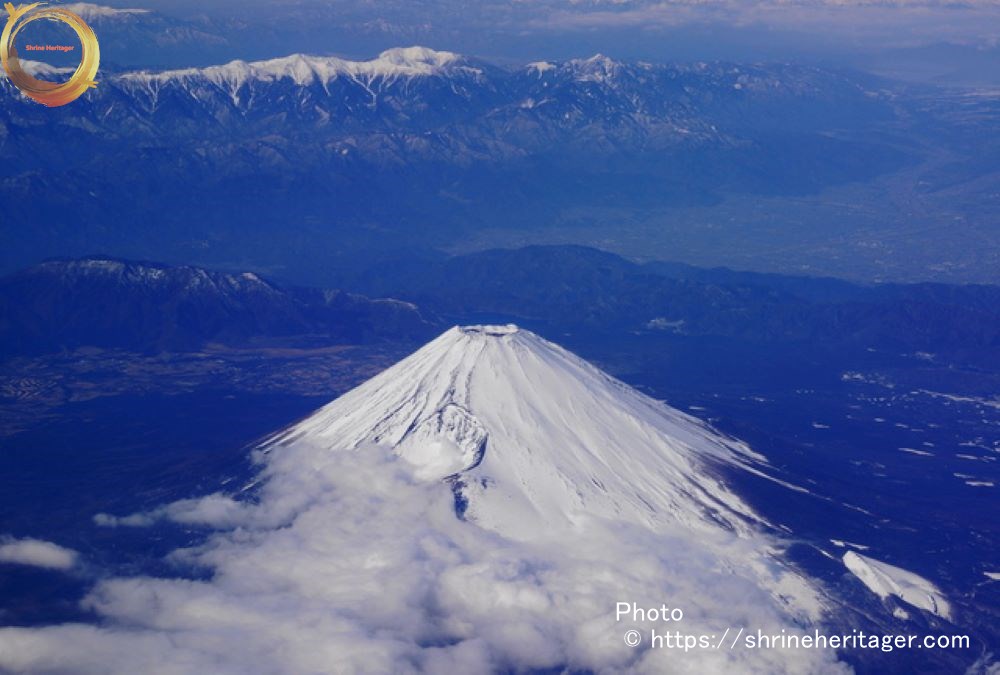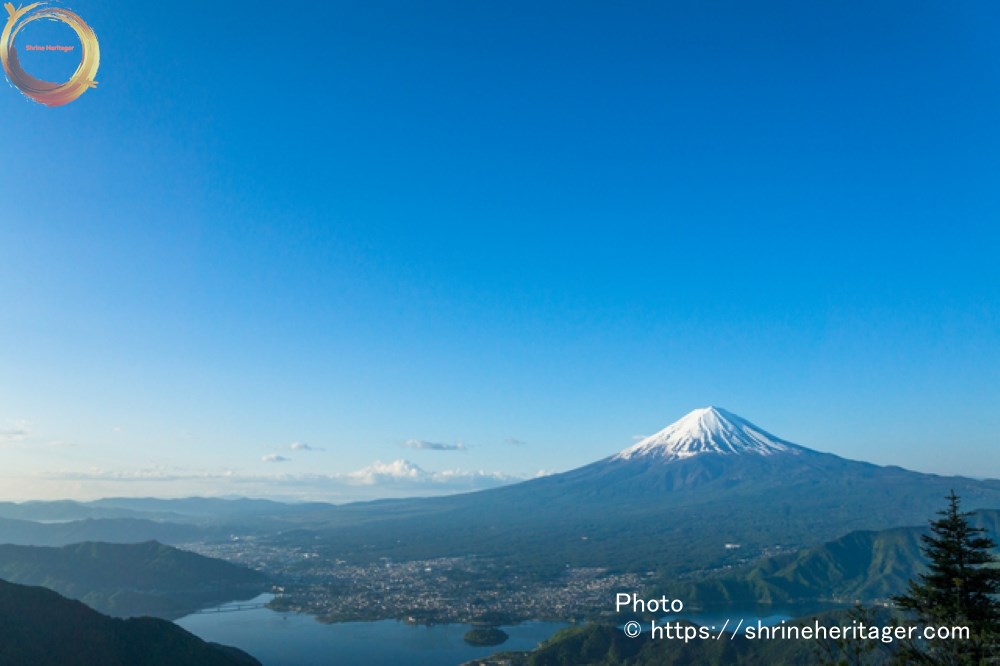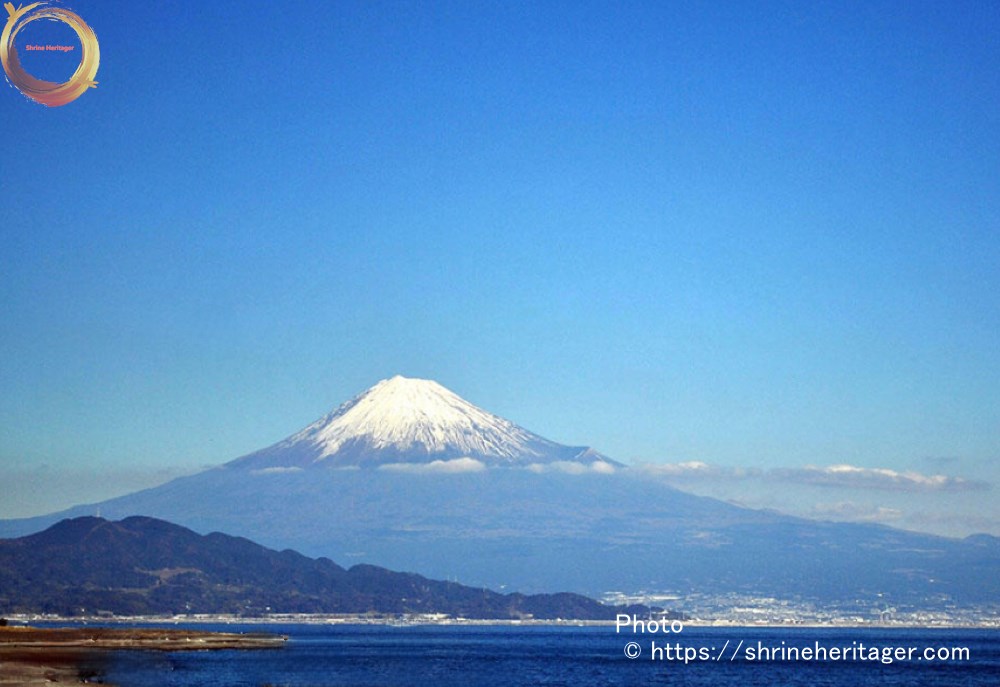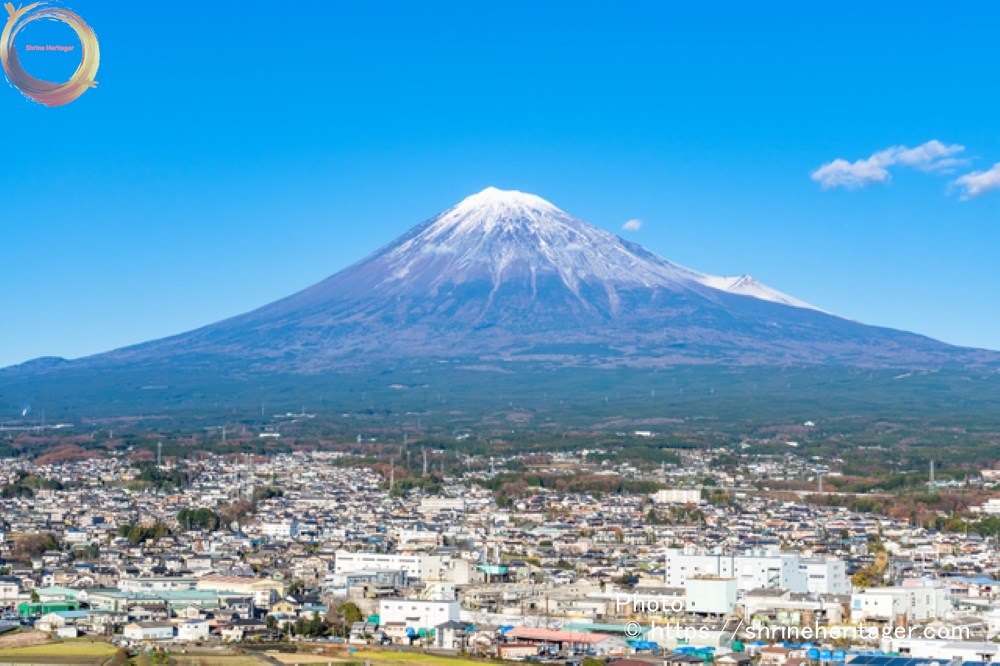World Cultural Heritage "Fujisan, sacred place and source of artistic inspiration"Criteria(iii)of the World Cultural Heritage "Mt. Fuji has continued to inspire a tradition of mountain worship from ancient times to the present day. Through ascending to the summit and making pilgrimages to sacred places at the foot of the mountain, pilgrims have hoped to immerse themselves in the spiritual powers of the gods and Buddha who call it their home.

Please do not reproduce without prior permission.
目次
- 1 Mt. Fuji World Cultural Heritage Assets〈25 items〉
- 2 1 Fujisan Mountain Area
- 2.1 1-1 Mountaintop worship sites
- 2.2 1-2 Omiya-Murayama Ascending Route (present Fujinomiya Ascending Route)
- 2.3 1-3 Suyama Ascending Route (present Gotemba Ascending Route)
- 2.4 1-4 Subashiri Ascending Route
- 2.5 1-5 Yoshida Ascending Route
- 2.6 1-6 Kitaguchi Hongu Fuji Sengen-jinja Shrine
- 2.7 1-7 Lake Saiko
- 2.8 1-8 Lake Shojiko
- 2.9 1-9Lake Motosuko
- 3 2 Fujisan Hongu Sengen Taisha Shrine
- 4 3 Yamamiya Sengen-jinja Shrine
- 5 4 Murayama Sengen-jinja Shrine
- 6 5 Suyama Sengen-jinja Shrine
- 7 6 Fuji Sengen-jinja Shrine (Subashiri Sengen-jinja Shrine)
- 8 7 Kawaguchi Asama-jinja Shrine
- 9 8 Fuji Omuro Sengen-jinja Shrine
- 10 9 . 10“Oshi” Lodging House (Former House of the Togawa Family), (House of the Osano Family)
- 11 11 Lake Yamanakako
- 12 12 Lake Kawaguchiko
- 13 13~20 Oshino Hakkai springs 〈・Deguchiike Pond・Okamaike Pond・Sokonashiike Pond・Choshiike Pond・Wakuike Pond・Nigoriike Pond・Kagamiike Pond・Shobuike Pond〉
- 14 21 Funatsu lava tree molds
- 15 22 Yoshida lava tree molds
- 16 23 Hitoana Fuji-ko Iseki
- 17 24 Shiraito no Taki waterfalls
- 18 25 Mihonomatsubara pine tree grove
- 19 世界文化遺産「富士山-信仰の対象と芸術の源泉」概要
Mt. Fuji World Cultural Heritage Assets〈25 items〉
World Cultural Heritage "Fujisan, sacred place and source of artistic inspiration" (Fuji-san-Shinkou no Taishō to Geijutsu Gensen -In this article, we will look at the relationship between the Sengen Shrine at the entrance to the mountain, which is a significant part of the beliefs of Mt.
スポンサーリンク
1 Fujisan Mountain Area
1-1 Mountaintop worship sites
Fuji, including the Okumiya Shrine and the torii gate of the Mt.
Fuji was an "object of faith" and a place of ascetic practices.
・〈富士山頂上 奥宮〉富士山頂上 浅間大社 奥宮 & 富士山頂上 久須志神社
1-2 Omiya-Murayama Ascending Route (present Fujinomiya Ascending Route)
The Omiya-Murayama-guchi trail is an old trail that starts at the Mt. Fuji Hongu Sengen Taisha Shrine, passes through the Murayama Sengen Shrine, and ends at the south side of the summit.
The asset range of the trail corresponds to the current Fujinomiya-guchi trail above the sixth station.
・Mt. Fuji Hongu Sengen Taisha Shrine (Miyamachi, Fujinomiya City) Ichinomiya in Suruga Province
・Murayama Sengen Shrine (Murayama, Fujinomiya City)
1-3 Suyama Ascending Route (present Gotemba Ascending Route)
The Suyama-guchi trail starts from Suyama Sengen Shrine and leads to the southeastern part of the summit. The area of the trail's assets is above the 2,050-meter elevation of the current Gotemba-guchi trail and the area around "Suyama Otainai," which has long been the object of worship as a god of safe childbirth.
・Suyama Sengen Shrine(Suyama, Susono City)
1-4 Subashiri Ascending Route
The Susuriguchi trail starts at Fuji Sengen Shrine (Susuri Sengen Shrine) and joins the Yoshida-guchi trail at the 8th station to reach the eastern part of the summit.
The trail joins the Yoshida-guchi trail at the 8th station and leads to the eastern part of the summit. Of these, the asset range is above the fifth station.
・SubashiriSengen Shrine〈Higashiguchi Hongu Fuji Sengen Shrine〉 (Subashiri, Oyama-cho, Sunto-gun)
1-5 Yoshida Ascending Route
The Yoshida-guchi trail starts at theKitaguchi Hongu Fuji Sengen-jinja Shrineand continues to the east side of the summit.
The asset range of the trail is the entire section of the trail.
1-6 Kitaguchi Hongu Fuji Sengen-jinja Shrine
Kitaguchi Hongu Fuji Sengen-jinja Shrineis located in the city of Fujiyoshida and is said to have its origins in a shrine dedicated to the great god Sengen.
The shrine was founded by Yamatotakeru no Mikoto, a legendary hero of ancient Japan, to worship the divine spirit of Mt.
Yohai" means to worship at a holy place from a distant place.
・Kitaguchi Hongu Fuji Sengen Shrine(Kamiyoshida, Fujiyoshida City)
1-7 Lake Saiko
Lake Saiko is located in Fujikawaguchiko Town and is one of the five lakes of Fuji.
Until the mid-9th century, it was a huge lake called Seno-Umi.
Fuji erupted in 864, and lava flows filled most of the lake, forming the current Lake Saiko.
1-8 Lake Shojiko
Lake Shojiko is known as the smallest of the Fuji Five Lakes.
Like Saiko (Lake Saiko), Shojiko was the site of the "Uchihachikai Tour," a tour of eight lakes and marshes around Mt. Fuji, conducted by many Fuji worshippers. Fuji, and the lakes are closely associated with the belief in Mt.
1-9Lake Motosuko
Lake Motosuko is the deepest of the Fuji Five Lakes.
Along with Saiko and Shojinko, Lake Motosuko was the site of the "Uchihachikai Tour," a tour of the eight lakes and marshes around Mt. Fuji, and is deeply connected with the belief in Mt.
スポンサーリンク
2 Fujisan Hongu Sengen Taisha Shrine
Fujisan Hongu Sengen Taisha Shrine is the head shrine of all "Sengen Shrines" in Japan, which worship Asama no Okami, the deity of Mt.
Fuji, and is enshrined as the center of the Fuji faith.
Fuji. In the precincts of the shrine, there is a spring called "Waku-tama-ike" where climbers used to perform mizugoriri (purification with water) before climbing Mt.
.・Mt. Fuji Hongu Sengen Taisha Shrine (Miyamachi, Fujinomiya City) Ichinomiya in Suruga Province
スポンサーリンク
3 Yamamiya Sengen-jinja Shrine
Yamamiya Sengen-jinja Shrine is the original shrine of the Mt. Fuji Hongu Sengen Taisha Shrine.
The shrine is said to have been founded by Yamatotakeru no Mikoto (Prince of Japan) and boasts a history of over 1,900 years. It is considered the oldest of all the Sengen shrines in Japan.
Fuji as its deity, the shrine is a far-off place of worship <hangai is a method of worshipping the sacred place from a distance>, and there is no shrine pavilion, thus preserving the old form of Fuji worship.
・〈Motomiya〉Yamamiya Sengen Shrine (Yamamiya, Fujinomiya)
スポンサーリンク
4 Murayama Sengen-jinja Shrine
Murayama Sengen-jinja Shrine was once the starting point of the Murayama Mountain Trail.
Fuji Kohoji, and was once a place of ascetic practice for ascetic practitioners who believed in Mt. Even today, the temple's Dainichido is enshrined within the precincts of the temple, along with Sengen Shrine, as part of the Shinto/Buddhist syncretism practice. Fuji Shugendo, and the history of the faith is handed down to the present day.
・Murayama Sengen Shrine (Murayama, Fujinomiya City)
5 Suyama Sengen-jinja Shrine
・Suyama Sengen-jinja Shrine is the starting point of the Suyama-muchi trail.
According to shrine legend, the shrine was founded by Yamatotakeru no Mikoto, a deity of the mountain, and those seeking to reach the summit from the Suyama-muchi trail would purify their minds and bodies and pray for the safety of their ascent.
・Suyama Sengen-jinja Shrine(Suyama, Susono City)
6 Fuji Sengen-jinja Shrine (Subashiri Sengen-jinja Shrine)
Fuji Sengen-jinja Shrine is the starting point of the Subashiri trail.
Fuji erupted in the 21st year of Enryaku (802 AD), and the shrine was built (807 AD) on the site where a fire ceremony was held to quell the eruption. This is believed to be the origin of the shrine. During the Edo period (1603-1867), many followers visited the shrine during the period when the Fuji-ko religion was active.
・Fuji Sengen-jinja Shrine〈Higashiguchi Hongu Fuji Sengen Shrine〉 (Subashiri, Oyama-cho, Sunto-gun)
7 Kawaguchi Asama-jinja Shrine
Kawaguchi Asama-jinja Shrine is located at the northern foot of Mt.
In 864 A.D., lava filled the Se-no-Umi, which was a huge lake, to form Lake Saiko and Lake Shojiko, giving rise to the Aokigahara Jukai (Aokigahara Sea of Trees). The Jogan eruption was the first time that Asama no Okami was enshrined at the northern foot of the mountain, and the shrine was founded in the 7th year of Jogan (865 AD).
The approach to the shrine and its grounds are lined with large, ancient cedar trees that inspire awe in the hearts of all who visit.
・Kawaguchi Asama-jinja Shrine (Fujikawaguchiko Town)
8 Fuji Omuro Sengen-jinja Shrine
Fuji Omuro Sengen-jinja Shrine located along the Yoshida-guchi trail.
Fuji, and has functioned as an important center of Mt. Fuji worship, with the main shrine (Motomiya), located at the second station of Mt. Fuji, and the satomiya, a local deity of production, functioning as a single entity. This is an extremely unique shrine.
The Motomiya is said to have been dedicated in 699 A.D. at the second station of Mt. Fuji, and the shrine was built in 807. In 958 A.D., Emperor Murakami built the Satomiya on the southern shore of Kawaguchi Lake.
・Fuji Omuro Sengen-jinja Shrine Hongu Satomiya(Katsuyama, Fujikawaguchiko)
9 . 10“Oshi” Lodging House (Former House of the Togawa Family), (House of the Osano Family)
The (Former House of the Togawa Family and (House of the Osano Family were the homes of people called "onshi," or "masters.
Onshi were professionals who provided lodging and meals for Fuji worshippers when they climbed the mountain, and also engaged in missionary activities and prayers for the faith of Mt.
11 Lake Yamanakako
Lake Yamanakako is located in the northeast at the foot of Mt. Fuji. It is the largest of the Fuji Five Lakes and the closest to Mt.
Fuji. In the old days, many Fuji worshippers used to make the "Uchihachikai Tour" to visit the eight lakes and marshes around Mt.
12 Lake Kawaguchiko

Please do not reproduce without prior permission.
Lake Kawaguchiko is located in the northeast at the foot of Mt. Kawaguchiko, like Yamanakako, was once the site of the "Uchihachikai Tour," a tour of the eight lakes and marshes around Mt. Fuji, and the lake is closely associated with the belief in Mt.
13~20 Oshino Hakkai springs
〈・Deguchiike Pond・Okamaike Pond・Sokonashiike Pond・Choshiike Pond・Wakuike Pond・Nigoriike Pond・Kagamiike Pond・Shobuike Pond〉
Oshinohakkai are eight spring-fed ponds fed by subterranean water from Mt.
Fuji, and was chanted as "Fuji-san nemoto hakko" (eight lakes of Mt. Fuji) in reference to the ascetic practices of Hasegawa Kakugyo at Fuji Hakkai Shugyo. It is said to be a sacred site of the ancient site. Fuji, and was rebuilt in 1843 by the followers of Fuji Ko. The eight lakes are each enshrined with eight great dragon kings, and as a place of pilgrimage related to Fuji worship, ascetic ascetics purify their bodies and souls with this water.
21 Funatsu lava tree molds
It is said that Hasegawa Kakugyo, the founder of Fuji-ko, discovered Funatsu lava tree molds when he climbed Mt.
lava tree molds is so called because the interior of the lava jyutata resembles the interior of a human womb, and is the object of worship. People have come to perform a religious act called "tainai-meguri," in which they walk through the interior of the tree.
Among these, Funatsu lava tree molds and Yoshida lava tree molds were especially emphasized by many followers of Fuji Ko, and are regarded as sacred sites.
・Mudomuro Sengen Shrine 〈Funatsu Utanai Shrine〉 (Fujikawaguchiko Town)
22 Yoshida lava tree molds
Yoshida lava tree molds, along with Funatsu lava tree molds, is a place that is considered sacred by many Fuji worshippers.
Fuji erupted in 937 A.D. and was formed by the lava that flowed out of the mountain. Fuji erupted in 937 A.D. Approximately 60lava tree molds are distributed in the surrounding area.
The interior of the Yoshida Tainai Shape is closed to the public. The interior of the Yoshida Tainai Archetype is not open to the public, but can be seen once a year during the festival held on April 29.
23 Hitoana Fuji-ko Iseki
The remains of the Fuji-ko Ruins are located in the precincts of the Hitoana Sengen Shrine.
It is said that Hasegawa Kakugyo, the founder of Fuji-ko, entered into ascetic practice at this cave and died there.
This man cave (lava cave) was said to be "the place where Sengendai Bosatsu (Great Bodhisattva Asama) resided. It is a lava cave with a total length of 83 meters. It is believed to have been created by lava that flowed out of the cave during the eruption (about 7,000 years ago) of Mt.Fuji
・Hitoana Sengen Shrine(Fujinomiya City Hitoana)
24 Shiraito no Taki waterfalls
Shiraito no Taki waterfalls is a beautiful and gentle waterfall that looks like many silk threads falling from the underground water of Mt. Fuji, which is 20 meters high and 150 meters wide.
This is the place where Hasegawa Kakugyo, the founder of Fuji-ko, did his ascetic training. It became a place of pilgrimage and ascetic practice for the Fuji-ko and others.
25 Mihonomatsubara pine tree grove

Please do not reproduce without prior permission.
Mihonomatsubara pine tree grove is a pine forest with about 30,000 pine trees growing along the coastline. Because of the beauty of its scenery, it has long been considered a sacred place overlooking Mt.
This place was beautifully told by the legend of a heavenly maiden, and was familiar to people and famous throughout the country for a long time. Located about 45 km southwest of the summit of Mt. Fuji, it is the most distant of the World Heritage sites.
〈Reference〉・Miho Shrine (Miho, Shimizu-ku, Shizuoka City)
世界文化遺産「富士山-信仰の対象と芸術の源泉」概要
出典:農林水産省Webサイト 森林整備部森林利用課より
https://www.rinya.maff.go.jp/j/sin_riyou/sekaiisan/fujisan.html#:~:text=%E3%82%AF%E3%83%A9%E3%82%A4%E3%83%86%E3%83%AA%E3%82%A2%EF%BC%88iii%EF%BC%89%E7%8B%AC%E7%AB%8B%E6%88%90%E5%B1%A4%E7%81%AB%E5%B1%B1,%E5%90%B9%E3%81%8D%E8%BE%BC%E3%82%80%E3%81%93%E3%81%A8%E3%82%92%E9%A1%98%E3%81%A3%E3%81%9F%E3%80%82
| 名称 | 「富士山-信仰の対象と芸術の源泉」 Fujisan, sacred place and source of artistic inspiration |
| 所在地 | 山梨県・静岡県 |
| 面積 | 構成資産面積:20,702.1ha、緩衝地帯面積:49,627.7ha 構成資産面積の約9割が森林であり、そのうち約4割が国有林野。 |
| 構成資産の 保護措置 | 文化財保護法、自然公園法及び国有林野の管理経営に関する法律 |
| 登録基準への適合 | クライテリア(iii)独立成層火山としての荘厳な富士山の形姿は、間欠的に繰り返す火山活動により形成されたものであり、古代から今日に至るまで山岳信仰の伝統を鼓舞し続けてきた。頂上への登拝と山麓の霊地への巡礼を通じて、巡礼者はそこを居処とする神仏の霊能を我が身に吹き込むことを願った。これらの宗教的関連性は、その完全な形姿としての展望を描いた無数の芸術作品を生み出すきっかけとなった富士山への深い憧憬、その美しさへの感謝、自然環境との共生を重視する伝統と結び付いた。一群の構成資産は、富士山とそのほとんど完全な形姿に対する崇敬を基軸とする生きた文化的伝統の類い希なる証拠である。 クライテリア(vi)湖沼及び海から立ち上がる独立成層火山としての富士山の図像は、古来、詩・散文その他の芸術作品にとって、創造的感性の源泉であり続けた。とりわけ19世紀初期の葛飾北斎及び歌川広重により浮世絵に描かれた富士山の図像は、西洋の芸術の発展に顕著な影響をもたらし、今なお高く評価されている富士山の荘厳な形姿を世界中に知らしめた。 |
| 構成資産 | 1 富士山域 1-1 山頂の信仰遺跡群 1-2 大宮・村山口登山道(現富士宮口登山道) 1-3 須山口登山道(現御殿場口登山道) 1-4 須走口登山道 1-5 吉田口登山道 1-6 北口本宮冨士浅間神社 1-7 西湖 1-8 精進湖 1-9 本栖湖 2 富士山本宮浅間大社 3 山宮浅間神社 4 村山浅間神社 5 須山浅間神社 6 冨士浅間神社 7 河口浅間神社 8 冨士御室浅間神社 9 御師住宅(旧外川家住宅) 10 御師住宅(小佐野家住宅) 11 山中湖 12 河口湖 13~20 忍野八海 21 船津胎内樹型 22 吉田胎内樹型 23 人穴富士講遺跡 24 白糸ノ滝 25 三保松原
|

